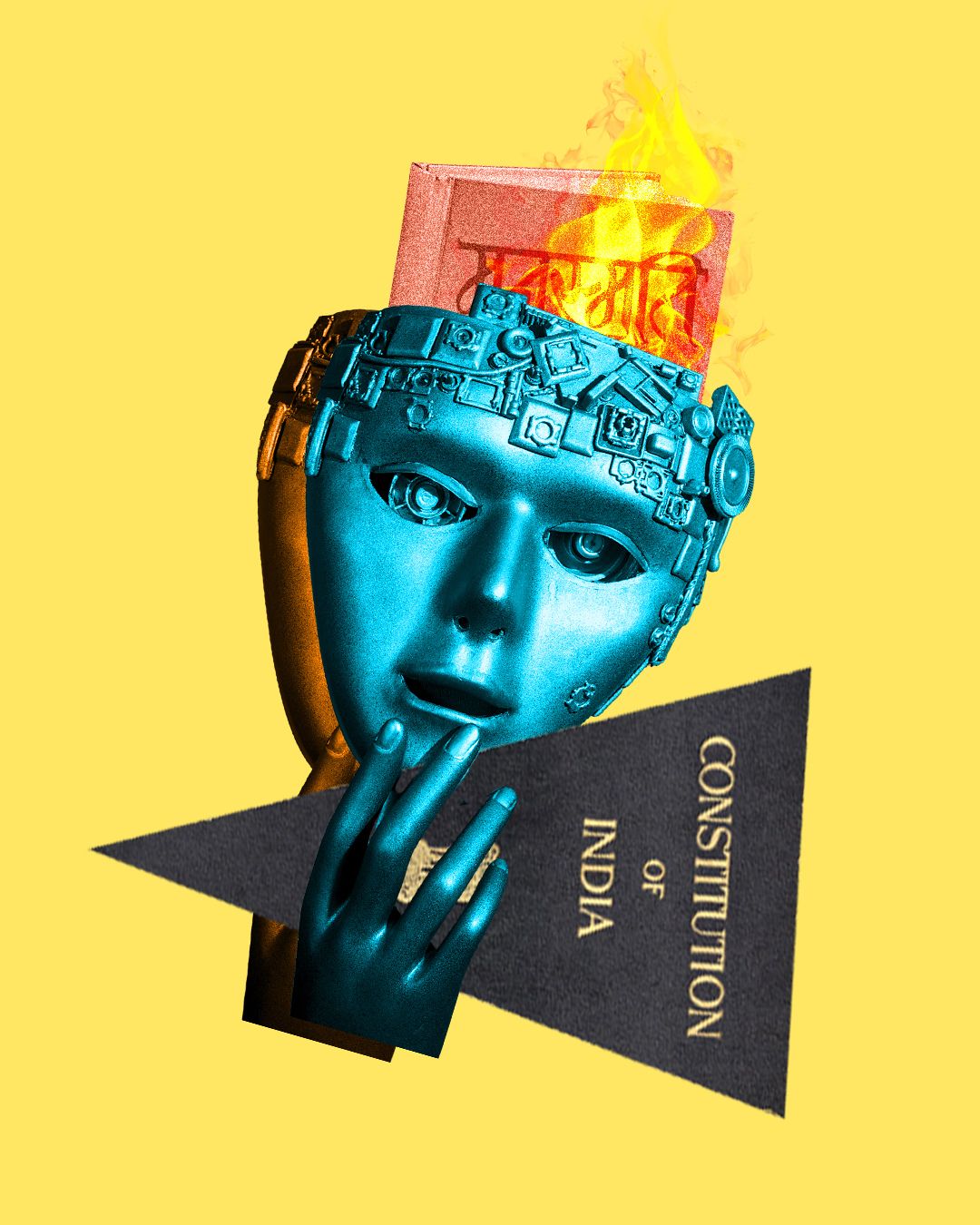When former President Ram Nath Kovind declared at the RSS centenary on 2nd October, 2025, that “Bhimsmriti is our guide, not Manusmriti; we are Ambedkarite” (Indian Express, 2024), I could not read it merely as ceremonial rhetoric. It was Atal Bihari Vajpayee who said it first at Dalit Sangam rally in 2001 when he was Prime Minister. All of it echoed in my own chaotic and political imagination as a call to revisit the foundational contest between the constitution as a proven textbook of Indian life and Manusmriti which is believed to be ancient Dharmasastra, long critiqued as the textual embodiment of caste hierarchy and ritual inequality. Bhimsmriti, shorthand for Babasaheb’s constitutional vision, embodied in the Indian Constitution, grounded in liberty, equality, fraternity, and justice.
Within right-wing bureaucracy and authoritative command structures, the manifesto of Manusmriti is being opposed by Dalits. Bhimsmriti — short, punchy, and resonant like Manusmriti emerges as its counterforce. To oppose Manusmriti’s stronghold, Bhimsmriti is narrated by those whose footsteps refuse to bow. It survives as a memory that refuses to die, even within right-wing institutions. At its core, Bhimsmriti constitutionalises equality, while Manusmriti institutionalised caste-inequality. Where Manusmriti sanctified birth as destiny, Bhimsmriti measures worth through reason and labour. Even within bureaucracy or on the ideological stage of the RSS, Bhimsmriti resists the codes of Manu and haunts their authority. It remains the ongoing struggle inside right-wing politics to make the Constitution a lived reality. Even in those sacred institutions of codified hierarchy and ritual purity, Bhimsmriti restores humanity.
This juxtaposition is not simply symbolic but represents a struggle between unconscious and conscious social orders. As Babasaheb himself argued in Annihilation of Caste (1936), caste is not just a law or rule but a “notion, a state of the mind”. The RSS, which claims to transcend caste through Hindu unity, remains tied to this unconscious inheritance.
This essay reflects my own engagement with these symbols, weaving personal intellectual concerns with theoretical resources from Babasaheb, Gramsci, Freud, Sartre and Lacan. I argue that the Manusmriti operates as an unconscious constitution, reproducing hierarchy not through written law but through customs, rituals, and deeply internalised codes that make caste as a tool of violence, discrimination and inequality which is perceived by our society as a natural and inevitable. In contrast, Bhimsmriti symbolises the conscious constitution, an Ambedkarite attempt to re-script society through explicit deliberation, rights, and the cultivation of constitutional morality grounded in equality, liberty, and fraternity. When read reflexively, Kovind’s intervention in invoking Bhimsmriti against Manusmriti destabilises the RSS’s claim to legitimacy, for it names and exposes the unconscious foundation of caste hierarchy on which the organisation’s cultural project continues to rely but rarely acknowledges.
Manusmriti as the Unconscious Constitution
The Manusmriti does not function today primarily as a read text but as what I call an unconscious constitution. By encoding caste hierarchy as natural and divinely sanctioned, it normalises inequality as “common sense.” Here Gramsci’s notion of hegemony becomes indispensable: social domination is effective not only through coercion but through cultural leadership, by making inequality appear natural, inevitable, and consensual (Gramsci, 1971).
Babasaheb’s critique anticipated this. He insisted that Manusmriti operates not merely as a set of rules but as a psychological structure: “Caste is not a division of labour; it is a division of labourers” (AoC). This distinction points directly to the unconscious dimension. One is not asked to sign on to Manusmriti; one is born into it, internalising hierarchy through ritual, kinship, and everyday codes. Psychoanalytic theory offers another lens. Freud conceived of the unconscious as the repository of repressed drives and desires, while Lacan extended this to argue that the unconscious is structured like a language, filled with symbols and codes that shape subjectivity. If caste operates through idioms of purity, pollution, honor, and shame, then it is precisely in this Lacanian unconscious that Manusmriti continues to live, irrespective of textual fidelity (Lacan, 1966). Thus, the Manusmriti becomes a silent constitution: not enforced by courts but by affect, repetition, and ritual sanction.
Bhimsmriti as Conscious Constitution
In contrast, Bhimsmriti functions as what Babasaheb called a project of constitutional morality, the deliberate choice to live by values of liberty, equality, and fraternity (AoC, The Grammar of Anarchy). Where Manusmriti governs unconsciously, Bhimsmriti insists on conscious allegiance.
It is a constitution that must be taught, learned, and reflected upon. Its power lies not in ritual inevitability but in deliberation, rights-based institutions, legal safeguards, and democratic practices. It is therefore aspirational: unlike the unconscious constitution aka Manusmriti, which demands conformity, Bhimsmriti demands continuous engagement and reflection. In this sense, Bhimsmriti is not merely the written Constitution of India but also the ethical horizon of Ambedkarite politics. It names the possibility of an alternative hegemony, one rooted in equality and justice. As Punya Prasun Bajpai observes in 100 Years of RSS, the Sangh’s politics thrives on paradox, preaching unity while enforcing hierarchy, invoking the Constitution while undermining its spirit. The paradox becomes policy, and the performance of contradiction becomes strategy. Bhagwat’s invocation of Babasaheb’s Grammar of Anarchy alongside “inherent cultural unity” isn’t accidental; it’s a psycho-political suturing attempt to overwrite rebellion with order, dissent with domestication.
In this context, the letter by the mother of the Chief Justice of India refusing participation in an RSS event becomes more than personal, it is an ethical interruption. It marks a refusal to let the symbolic order of Hindutva consume familial, moral, and civic conscience. That refusal, unlike Kovind’s reflective accommodation, is a moment of pure reflection, a conscious detachment from ideological captivity.
What does it mean when the enemy speaks your language? It means your truth has entered their unconscious mind.
The Ridden Unconscious: How Caste Persists
Why then does Manusmriti persist despite Bhimsmriti’s existence? Here I find myself returning to both psychoanalysis and cultural theory. It also leads me to think on why within RSS, there is echo of the Bhimsmriti when Samrastawadi Ambedkar already exists?
Freud taught us that the unconscious governs action even when it contradicts conscious intention, which explains why people may openly profess allegiance to equality yet continue to act out caste prejudice in practice. Building on this, Lacan demonstrated that symbolic structures, once inscribed, reproduce themselves through repetition, so caste persists not merely in law but in the very language, gestures, rituals, and silences that shape everyday life. Gramsci, from another angle, reminds us that hegemony relies on consent manufactured at precisely this unconscious level, through institutions such as family, religion, schooling, and media, which naturalise inequality and make it appear as common sense. The RSS has mastered this art of unconscious reproduction. Its deployment of symbols like the saffron flag, the rhetoric of “Hindu unity,” the myth of a golden age, acts much like branding in commercial advertising. Just as marketeers cultivate unconscious desires, the RSS cultivates affective attachment to hierarchy disguised as cultural pride.
This is why I describe the unconscious as ridden: saturated with codes, myths, and repetitions that reproduce inequality without requiring explicit enforcement.
Reflexivity: Reading Kovind’s Intervention
From my position as a researcher who engages both Ambedkarite and Marxist thought and cultural theory, I read Kovind’s statement as far more than symbolic accommodation. His invocation of Bhimsmriti directly names the unconscious constitution represented by Manusmriti and simultaneously calls for a conscious reorientation towards Ambedkar’s constitutional vision. By drawing such a sharp contrast between the two, he forces recognition of what usually remains hidden beneath the surface of social and political life.
In identifying explicitly as Ambedkarite, Kovind shifts the basis of belonging away from ritual identity and towards constitutional morality, thereby recasting the terms of citizenship and collective life. By making this claim from within an RSS platform, he also exposes the deep contradiction between the organisation’s self-image as a unifier of Hindu society and the unconscious foundations of hierarchy and exclusion upon which it continues to rest. Kovind must have been treated as a Dalit, in the organization. This resonates with my own intellectual practice: the effort to make visible what is ordinarily invisible in cultural and political life, and to read ideology not only at the level of institutions and structures but also at the subtler level of unconscious attachment and affect.
The Foundational Challenge to RSS
If Bhimsmriti is embraced as the true constitution, the RSS faces nothing short of a foundational crisis. Its claim to cultural legitimacy has long rested on unconscious hierarchies of caste and ritual order, precisely the structures that Bhimsmriti delegitimises through its insistence on equality, liberty, and fraternity. What Kovind’s intervention makes clear is that the RSS can no longer rely on “Hindu culture” as an unquestioned authority; it must instead answer to the higher bar of Babasaheb’s constitutional morality.
This tension also exposes a deeper contradiction. The RSS has presented itself as a force of Hindu unity, but its project collapses when measured against the demand for equality, since unity cannot coexist with entrenched hierarchy. In this light, its cultural hegemony becomes fragile. A counter-hegemony, rooted in Bhimsmriti—the Ambedkarite imagination—begins to challenge the unconscious consensus that the RSS has carefully cultivated over decades. This is the very struggle Gramsci described: between the “traditional intellectuals” who sustain existing power structures and the “organic intellectuals” who arise from oppressed communities to articulate alternative visions of society. Despite its own contradictions, Kovind’s intervention aligns more closely with the latter, positioning Ambedkarite constitutionalism as the intellectual and moral force capable of unsettling the RSS at its foundation.
What does it mean when the enemy speaks your language?
It means your truth has entered their unconscious mind. It means Bhimsmriti has become uncontainable. But it also warns us: when language is co-opted without consciousness, it becomes a simulation. The danger is not that they speak our words. The danger is that our words might begin to sound like theirs if we stop reflecting critically.
Conscious vs Unconscious Futures
The battle between Manusmriti and Bhimsmriti is, at its core, a struggle between unconscious reproduction and conscious reconstruction. As Sudipta Kaviraj (1997) reminds us, constitutions are not only legal texts but also political identities, shaping how societies imagine themselves. Ambedkar grasped this profoundly: democracy in India could only endure if people cultivated constitutional morality as a lived ethic, not merely a juridical form. Kovind’s intervention can thus be read as a socio-psycho-political act: it drags Manusmriti from the unconscious realm into conscious discourse, forcing India to confront the shadow constitution it often denies. In doing so, it reopens Babasaheb’s invitation to embrace what Gail Omvedt (2004) calls the “enlightened India” of constitution rooted in equality and justice.
The real question is not only which constitution we read but which one we live. Do we continue to inhabit the unconscious constitution of Manusmriti, reproducing hierarchy by habit, or do we consciously embrace the Ambedkarite constitution? That choice between a ridden unconscious and reflective constitutional morality is the true challenge for India today, and the foundational test for the RSS at its centenary.

